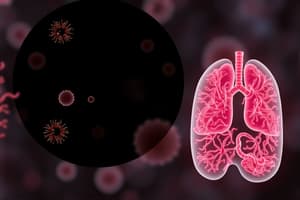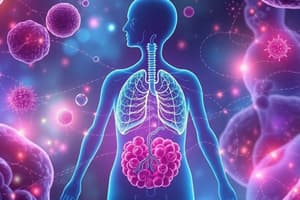Podcast
Questions and Answers
What is the main difference between aerobic and anaerobic respiration?
What is the main difference between aerobic and anaerobic respiration?
- The presence of water in the reaction
- The amount of ATP produced
- The final electron acceptor used (correct)
- The enzymes involved in the process
What is the end product of glycolysis in both aerobic and anaerobic respiration?
What is the end product of glycolysis in both aerobic and anaerobic respiration?
- ATP
- Pyruvate (correct)
- Lactic acid
- NADH
How many ATP molecules are produced through anaerobic respiration?
How many ATP molecules are produced through anaerobic respiration?
- Around 10 ATP
- 30-32 ATP
- 2 ATP (correct)
- No ATP
What happens to pyruvate in the absence of oxygen?
What happens to pyruvate in the absence of oxygen?
Which organelle plays a crucial role in the aerobic respiration process?
Which organelle plays a crucial role in the aerobic respiration process?
What is the function of the Krebs Cycle in cellular respiration?
What is the function of the Krebs Cycle in cellular respiration?
Which molecule serves as the final electron acceptor in aerobic respiration?
Which molecule serves as the final electron acceptor in aerobic respiration?
Glycolysis is the first step in both aerobic and anaerobic respiration.
Glycolysis is the first step in both aerobic and anaerobic respiration.
Aerobic respiration produces lactic acid as a byproduct.
Aerobic respiration produces lactic acid as a byproduct.
Anaerobic respiration produces more ATP molecules than aerobic respiration.
Anaerobic respiration produces more ATP molecules than aerobic respiration.
The Krebs Cycle takes place in the cytoplasm of the cell.
The Krebs Cycle takes place in the cytoplasm of the cell.
Oxidative phosphorylation is responsible for producing water and carbon dioxide in cellular respiration.
Oxidative phosphorylation is responsible for producing water and carbon dioxide in cellular respiration.
Anaerobic respiration always leads to the production of lactic acid.
Anaerobic respiration always leads to the production of lactic acid.
Acetyl CoA is a product of glycolysis.
Acetyl CoA is a product of glycolysis.
Aerobic respiration requires ______ and is the preferred method when oxygen is available to cells
Aerobic respiration requires ______ and is the preferred method when oxygen is available to cells
Anaerobic respiration occurs when ______ is not readily available
Anaerobic respiration occurs when ______ is not readily available
Both aerobic and anaerobic respiration start with ______
Both aerobic and anaerobic respiration start with ______
Glycolysis yields NADH, a few ATP molecules, and two ______ molecules from glucose
Glycolysis yields NADH, a few ATP molecules, and two ______ molecules from glucose
If oxygen is not present, pyruvate is converted into ______ in the anaerobic pathway
If oxygen is not present, pyruvate is converted into ______ in the anaerobic pathway
If oxygen is present, pyruvate is transported to the ______ for further reactions
If oxygen is present, pyruvate is transported to the ______ for further reactions
The Krebs Cycle, electron transport chain, and oxidative phosphorylation ultimately produce ______, carbon dioxide, and more ATP
The Krebs Cycle, electron transport chain, and oxidative phosphorylation ultimately produce ______, carbon dioxide, and more ATP
Match the following with their correct description:
Match the following with their correct description:
Match the following with their correct products:
Match the following with their correct products:
Match the following with their correct outcomes:
Match the following with their correct outcomes:
Match the following with their roles in respiration:
Match the following with their roles in respiration:
Match the following with their correct stages:
Match the following with their correct stages:
Match the following with their correct conversions:
Match the following with their correct conversions:
Match the following with their correct pathways:
Match the following with their correct pathways:
Flashcards are hidden until you start studying
Study Notes
- Aerobic respiration requires oxygen and is the preferred method when oxygen is available to cells, involving a series of steps using different enzymes to produce carbon dioxide, water, around 30-32 ATP, and heat.
- Anaerobic respiration occurs when oxygen is not readily available, resulting in the production of lactic acid, only two ATP molecules, and a little bit of heat, with pyruvate as the final electron acceptor.
- Both aerobic and anaerobic respiration start with glycolysis, which is the breakdown of glucose in the cytoplasm using various enzymes and involving an energy investment stage with an initial use of 2 ATP molecules.
- Glycolysis yields NADH, a few ATP molecules, and two pyruvate molecules from glucose, with the fate of pyruvate depending on the presence of oxygen.
- If oxygen is not present, pyruvate is converted into lactic acid in the anaerobic pathway, resulting in two ATP molecules.
- If oxygen is present, pyruvate is transported to the mitochondria for further reactions including the conversion to acetyl CoA, the Krebs Cycle, electron transport chain, and oxidative phosphorylation, ultimately producing water, carbon dioxide, and more ATP.
Studying That Suits You
Use AI to generate personalized quizzes and flashcards to suit your learning preferences.




